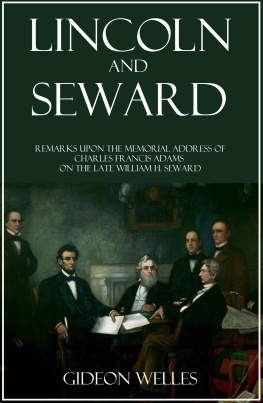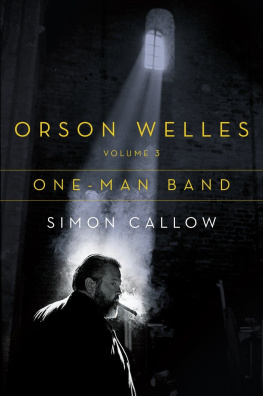
The author and publisher have provided this e-book to you for your personal use only. You may not make this e-book publicly available in any way. Copyright infringement is against the law. If you believe the copy of this e-book you are reading infringes on the authors copyright, please notify the publisher at: us.macmillanusa.com/piracy .
For Steve Bloom
Contents
Introduction
How Henry Met Orson
by Peter Biskind
O RSON W ELLES has long been regarded as one of the greatest filmmakers of all time, more specifically, the most gifted of a long line of gifted Hollywood mavericks that started with D. W. Griffith, or perhaps Erich von Stroheim. Today, his Citizen Kane , over seventy years after it was released in 1941, still finds a place on every Ten Best list. It topped the British Film Institutes Sight & Sound magazines survey for fifty years in a row, only to be toppled in 2012 by Alfred Hitchcocks Vertigo , a picture that Welles despised.
But we all know lists and such mean next to nothing in our awards-obsessed, rankings-ridden culture, and theres a much easier and infinitely more pleasurable way to judge the stature of Welles and his films: just watch them, starting with Citizen Kane . The opening, a dark and doomy shot of the massive iron gates of Xanadu capped by a gigantic K, with the Transylvanian ruins of Kanes folly looming above and behind it, grabs our attention, but at the same time warns us that there is more going on than meets the eye, so to speak, because its all too much, drama shading into melodrama, undermining itself with irony and camp.
Welles had a genius for the dramatic; he was a master of shock and awe long before they were turned to other, considerably less noble ends, but at the same time he was a skilled miniaturist who worked just as easily on a small canvas with lightness and subtlety. Above all, it was his wizardry with time, space, and light, along with the exquisite tension between his furious, operatic imagination and the elegant, meticulous design and execution of the filmthe deep focus, extreme camera angles, striking dissolves, ingenious transitionsthat make it crackle with electricity. After Kane , movies were never the same. When asked to describe Welless influence, Jean-Luc Godard remarked, simply, Everyone will always owe him everything.
Welles was not only a director, but a producer, a skilled actor and screenwriter, and a prolific author of essays, plays, stories, even a newspaper column. More often than not, he wore several of these hats at once, making him a veritable Bartholomew Cubbins of the arts. One finds oneself reaching in vain for adjectives adequate to describe him. As considerable as his gifts were, he himself was more than the sum of his parts, his own greatest production, a commanding, larger-than-life figure of equatorial girth who in later years sported a beard of biblical proportions that made him every casting directors first choice for deities and gurus of all sorts, from Jor-El (Marlon Brando eventually got the role) to God.
George Orson Welles was born on May 6, 1915, in Kenosha, Wisconsin. His parents, Richard Welles, an inventor, and Beatrice Ives, a pianist, artist, and suffragette, were a mismatched couple with a stormy marriage. Eventually, they separated, and his mother, who raised him, died at an early age. Dr. Maurice Dadda Bernstein, Beatrices close friend and rumored lover, became his guardian.
Welles was fiercely precocious. Even as a child, he read widely, showed a keen interest in music, and even became an amateur magician. He finished high school in two years, and got a scholarship to Harvard. He had a prodigious intellect, and was on intimate terms with the great literature of the Western canon, able to recite lengthy swatches of prose and poetry. But he preferred experience to book learning, and persuaded Dadda Bernstein to send him on a walking tour of Ireland when he was only sixteen. Aided by raw talent and boyish good lookshe was over six feet tall, with blond hair and a face like a baby with a little snub nose that always embarrassed himhe talked his way into a small part in a play at the Gate Theatre in Dublin, run by Hilton Edwards and Michel Mac Liammir, that started him on his way.
Returning to the States, he soared through New Yorks theater world and was dubbed the boy wonder before he was out of his teens. In 1936, Welles was hired by the Federal Theatre. Fascinated by modernist figures like Max Reinhardt and Bertolt Brecht, he was unafraid to surprise the classics by putting them in contemporary settings, like his triumphant so-called Voodoo Macbeth , that he produced that year when he was only twenty-one, with an all-black cast. Although he venerated the classics, no text was so sacrosanct that Welles wouldnt or couldnt have his way with it. The following year, he produced his Blackshirt Julius Caesar , which he turned into an allegory of fascism. (He played Brutus.)
Although he never swallowed the Stalinist line, Welles breathed the heady fervor of those Popular Front years. He considered himself a New Deal liberal, and later would brush up against President Franklin D. Roosevelt, who used him in various ways, taking full advantage of his rhetorical and oratorical skills, most famously his booming voice that sounded like the rumble of not-so-distant thunder.
In between Macbeth and Caesar , Welles created a scandal with Marc Blitzsteins operetta The Cradle Will Rock in 1937. The feds padlocked the doors of the theater where it was set to open, apparently because FDR and/or his advisors feared that its full-throated defense of unions in general and striking workers at Republic Steel in particular (ten were shot by Chicago police in the so-called Memorial Day Massacre), would provoke their enemies in Congress to further slash funding for the Federal Theatre and its parent, the Works Progress Administration. On June 16, 1937, amid a firestorm of press, hundreds of ticket holders marched twenty blocks to New Yorks Venice Theatre, where they were treated to a bare-bones production in which Blitzstein played the piano on stage while the cast, scattered about the audience, performed the songs. That same year, Welles founded the Mercury Theatre, another successful enterprise. It seemed that he could do no wrong. Three days after his twenty-third birthday, on May 9, 1938, TIME magazine put him on the cover.
Controversywelcome and unwelcomecontinued to dog Welless footsteps. After creating a name for himself in radio, most famously playing Lamont Cranston, or the Shadow, in the series of the same name, he was given his own show on CBS. His Halloween broadcast on October 30, 1938, adapted from H. G. Wellss War of the Worlds , panicked millions of Americans with its urgent, you-are-there style coverage of a Martian invasion, although the target of the ostensible attack, not Washington, D.C., not New York City, but Grovers Mill, New Jersey, should have given listeners pause.
Two years later, the new head of RKO, George Schaefer, gave Welles an unprecedented two-film contract with final cut that shocked and angered the industry. Welles embarked on Citizen Kane , which he wrote (with Herman J. Mankiewicz), directed, and headlined. The picture earned him the enmity of news baron William Randolph Hearst, on whose life it was loosely based, and whose petit nom damour for his lover Marion Daviess nether partRosebudthe picture made famous, although, to be sure, there are other claimants to that particular honor.
Kane premiered on May Day, 1941, when Welles was all of twenty-five years old. Hearst made a feverish attempt to block the release of the movie. According to Hearst columnist Louella Parsons in her autobiography, several studio heads, including L. B. Mayer and Jack Warner refused to book the picture in their theaters. Hearst also threatened to decline ads from RKO. Schaefer held fast, but Hearst did manage to force Kane into smaller, independent, and therefore less profitable venues, damaging the box office. In the last analysis, though, Kane was just too sophisticated for a mass audience, and RKO lost an estimated $150,000 on the picture.
Next page










